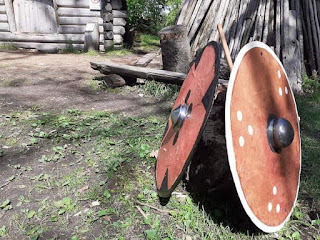Testing thin and thick shields against Viking Age weapons

We have build two shield with similar construction. Both are made just like the one we named Fat little sister , with the exception that the other ( Skinny brother ) is made of 6 mm thick planks and the fat one is made out of 10 mm thick planks. Read about the construction of the Fat little sister from this blog post: https://hirdmenn.blogspot.com/2022/01/fat-little-sister-making-of-sturdy.html The black paint is on the 6 mm thick shield and the white paint on the 10 mm thick shield. Both are of spruce tree from the same order, so probably of the same age, maybe even from the same tree. The glueing was done the same way for both boards using same hide glue. Both have tanned leather facings from the same manufacturer. Both have raw hide edging from the same leather. The only difference is that the skinny one is painted with black iron oxide paint and the fat one has white chalk paint on it. Both are thinned down to 3 mm thickness on the edge, but the skinny one is shaved from 5 cm o


